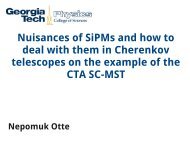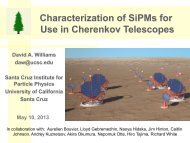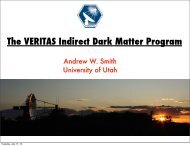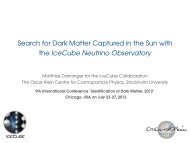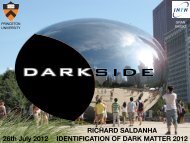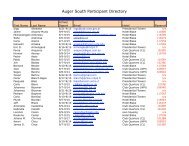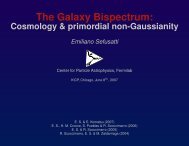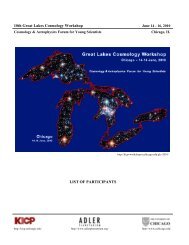z - KICP Workshops - University of Chicago
z - KICP Workshops - University of Chicago
z - KICP Workshops - University of Chicago
Create successful ePaper yourself
Turn your PDF publications into a flip-book with our unique Google optimized e-Paper software.
Optical/NIR Imaging Surveys<br />
Josh Frieman<br />
DES Project Director<br />
Fermilab and <strong>University</strong> <strong>of</strong> <strong>Chicago</strong><br />
Cosmology in the Era <strong>of</strong> Extremely Large Telescopes<br />
June 10, 2013
2<br />
New Generation <strong>of</strong> Large<br />
Imaging Surveys<br />
• Science Goals (varying, but common themes):<br />
– Cosmology/Dark Energy<br />
– Galaxy Formation and Evolution<br />
– Time-Domain Studies<br />
– Local (Galactic) Structure<br />
– …<br />
• Billions <strong>of</strong> targets for ELT Follow-up<br />
• Immense synergies to be exploited
3<br />
Brief Survey <strong>of</strong> New Imaging Surveys<br />
• Dark Energy Survey (2013-18)<br />
• Hyper Suprime-cam surveys (2014-18)<br />
• LSST (2021-31)<br />
• Euclid (2020-26)<br />
• WFIRST/AFTA (early 2020’s?)<br />
• With apologies to PanSTARRS, Skymapper,…<br />
• Dates are notional survey start dates, based on<br />
recent information from participants/proponents
4 Takada<br />
heading toward deep, wide<br />
AFTA NIR<br />
VIS<br />
NIR
5<br />
Dark Energy<br />
• What is the physical cause <strong>of</strong> cosmic acceleration?<br />
– Dark Energy or modification <strong>of</strong> General Relativity?<br />
• If Dark Energy, is it Λ (the vacuum) or something else?<br />
– What is the DE equation <strong>of</strong> state parameter w and<br />
(how) does it evolve?<br />
70%<br />
25%
1.5<br />
What can we probe?<br />
• Probe Ω =0.2, dark w=-1.0<br />
M energy through the history <strong>of</strong> the expansion rate:<br />
H 0 r(z)<br />
H 2 (z)<br />
2<br />
H0 = Ωm (1+ z)3 Ω =0.3, w=-1.0<br />
M<br />
+ ΩDE exp[ 3 ∫ (1+ w(z))dln(1+ z) ] Ω =0.2, w=-1.5<br />
M w=−1/3+<br />
( 1− Ωm − ΩDE ) 1+ z<br />
Ω =0.2, w=-0.5<br />
M<br />
1.0<br />
r(z) = ∫ dz'/H(z')<br />
0.1<br />
0.5 • and the growth <strong>of</strong> large-scale structure:<br />
0.0<br />
Require both to disentangle Dark Energy from Modified Gravity<br />
Distance vs.<br />
Redshift<br />
0.0<br />
€<br />
0.5 1.0<br />
redshift z<br />
1.5 2.0<br />
• Weak Lensing cosmic shear Distances+growth<br />
• Supernovae Distances<br />
• Baryon Acoustic Oscillations Distances and H(z)<br />
• Cluster counting Distances+growth<br />
• Redshift Distortions Growth<br />
δ(z)/δ(today)<br />
€<br />
1<br />
δρ<br />
( ) 2<br />
ρ (z; Ωm ,ΩDE ,w(z),...)<br />
Growth <strong>of</strong><br />
w=−1<br />
10.0<br />
Density<br />
Perturbations<br />
z<br />
1.0<br />
6<br />
0.1
7<br />
• Clusters are proxies for massive<br />
halos and can be identified<br />
optically to redshifts z>1<br />
• Galaxy colors provide<br />
photometric redshift estimates for<br />
each cluster<br />
• Observable proxies for cluster<br />
mass: optical richness, SZ flux<br />
decrement, weak lensing mass,<br />
X-ray flux<br />
• Challenge: determine massobservable<br />
relation p(O|M,z) with<br />
sufficient precision<br />
d 2 N<br />
dzdΩ = r2 (z)<br />
H(z)<br />
∫<br />
I. Clusters<br />
Number <strong>of</strong> clusters above mass threshold<br />
€<br />
f (O,z)dO p(O | M,z) dn(z)<br />
∫<br />
dM<br />
dM<br />
Dark Energy<br />
equation <strong>of</strong> state<br />
dN(z)<br />
dzdΩ<br />
dV<br />
= n( z)<br />
dz dΩ<br />
Mohr<br />
Volume Growth
8<br />
II. Weak Lensing: Cosmic Shear<br />
Observer<br />
Dark matter halos<br />
• Spatially coherent shear pattern, ~1% distortion<br />
Background<br />
sources<br />
• Radial distances depend on expansion history <strong>of</strong> Universe<br />
• Foreground mass distribution depends on growth <strong>of</strong> structure
Cosmic Shear Tomography
10<br />
III. Large-scale Structure
11<br />
Galaxy angular<br />
power spectrum<br />
in photo-z bins<br />
(relative to model<br />
without BAO)<br />
Photometric<br />
surveys provide<br />
angular measure<br />
Radial modes<br />
require<br />
spectroscopy<br />
Baryon Acoustic Oscillations<br />
Fosalba & Gaztanaga
B. Dilday<br />
IV. Supernovae<br />
SDSS-II: 500 spectroscopically confirmed SNe Ia,<br />
>1000 with host redshifts from SDSS-III
13<br />
Photometric SN Cosmology<br />
• Hubble diagram<br />
<strong>of</strong> SDSS SNe Ia:<br />
spectroscopic<br />
plus those<br />
classified<br />
photometrically<br />
that have hostgalaxy<br />
redshifts<br />
• Future surveys<br />
will have SN<br />
spectra for only a<br />
small subsample<br />
Campbell, etal
14 Kuijken
16<br />
The Dark Energy Survey<br />
• Survey project using 4<br />
complementary techniques:<br />
I. Cluster Counts<br />
II. Weak Lensing<br />
III. Large-scale Structure<br />
IV. Supernovae<br />
• Two multiband imaging surveys:<br />
5000 deg 2 grizY to 24th mag<br />
30 deg 2 repeat griz (SNe)<br />
• New 3 deg 2 FOV camera<br />
on the Blanco 4m telescope<br />
Survey 2013-2018 (525 nights)<br />
Facility instrument for astronomy<br />
community (DES 30% time)<br />
DECam on the Blanco 4m at CTIO<br />
www.darkenergysurvey.org<br />
darkenergydetectives.org
17<br />
DES Science Summary<br />
Four Probes <strong>of</strong> Dark Energy<br />
• Galaxy Clusters<br />
• ~100,000 clusters to z>1<br />
• Synergy with SPT, VHS<br />
• Sensitive to growth <strong>of</strong> structure and geometry<br />
• Weak Lensing<br />
• Shape measurements <strong>of</strong> 200 million galaxies<br />
• Sensitive to growth <strong>of</strong> structure and geometry<br />
• Baryon Acoustic Oscillations<br />
• 300 million galaxies to z = 1 and beyond<br />
• Sensitive to geometry<br />
• Supernovae<br />
• 30 sq deg time-domain survey<br />
• ~4000 well-sampled SNe Ia to z ~1<br />
• Sensitive to geometry<br />
Forecast Constraints on DE<br />
Equation <strong>of</strong> State<br />
DES<br />
Planck prior assumed<br />
DETF Stage III Experiment
18<br />
DECam CCDs<br />
• 62 2kx4k fully depleted CCDs: 520 Megapixels, 250<br />
micron thick, 15 micron (0.264”) pixel size<br />
• 12 2kx2k guide and focus chips<br />
• Excellent red sensitivity<br />
• Developed by LBNL, packaged and tested at FNAL<br />
• Total 570 Megapixels<br />
DECam / Mosaic II QE comparison<br />
2.2 deg<br />
100<br />
90<br />
80<br />
70<br />
60<br />
50<br />
40<br />
30<br />
20<br />
10<br />
QE, LBNL (%)<br />
QE, SITe (%)<br />
0<br />
300 400 500 600 700 800 900 1000 1100<br />
Wavelength (nm)
570-Mpix<br />
DECam<br />
imager
DECam First Light<br />
September 12, 2012<br />
Covered in 258 publications in 36 countries, plus Jay Leno’s monologue
DECam<br />
1x1deg<br />
grizY co-add<br />
image <strong>of</strong> SPT<br />
cluster<br />
z=0.32<br />
~50,000 galaxies<br />
in this image
High Redshift Cluster Discovered by DES<br />
from DES Science Verification data in November
• Stacked (statistical)<br />
Weak Lensing cluster<br />
shear pr<strong>of</strong>iles will<br />
calibrate cluster<br />
mass-observable<br />
relations<br />
• Preliminary cluster<br />
mass map from DES<br />
Science Verification<br />
data<br />
Cluster Weak Lensing
DECam<br />
composite<br />
image <strong>of</strong> deep<br />
SN field<br />
will be visited<br />
many times<br />
during survey,<br />
resulting in very<br />
deep co-add
First Confirmed SNe from DES<br />
Nov. 7 Dec. 15<br />
SN Ia at z=0.2 confirmed at AAO<br />
100 nights on AAO awarded for follow-up (OzDES)
Science Verification:<br />
fewx100 sq deg to full DES<br />
depth (10 exposures in each<br />
band). Nov. 2012-Feb. 2013<br />
DES Survey Strategy<br />
Full survey area to be covered by Vista Hemisphere Survey (JHK)<br />
SPT SZ area<br />
(2500 sq deg)<br />
Stripe 82<br />
2 Deep SN fields<br />
8 Shallow SN fields<br />
Full Survey: 5000 sq deg<br />
10x90s exposures in<br />
each filter (shorter Y)
R. Mandelbaum<br />
Subaru telescope<br />
8.2 meter primary mirror<br />
Mauna Kea<br />
Excellent imaging<br />
conditions<br />
28
R. Mandelbaum<br />
Picture credit: S. Miyazaki<br />
29
HSC is on the telescope!<br />
First Light Sept. 2012<br />
R. Mandelbaum 30
Seeing variation across FOV<br />
104 Science, 4 Guide, 8 Focus CCDs<br />
870 Megapixels (0.17”/pixel)<br />
Looking good!<br />
Raw image <strong>of</strong> Andromeda<br />
R. Mandelbaum 31
R. Mandelbaum<br />
3-‐layer HSC survey<br />
Wide: ~1400 deg 2 , i
Takada<br />
R. Mandelbaum 33
The Large Synoptic Survey<br />
Telescope<br />
Steven M. Kahn<br />
Sidney Wolff<br />
Victor Krabbendam<br />
Nadine Kurita<br />
Zeljko Ivezic<br />
Cerro Pachon, Chile
Summary <strong>of</strong> High Level Requirements<br />
Survey Property Performance<br />
Main Survey Area 18000 sq. deg.<br />
Total visits per sky patch 825<br />
Filter set 6 filters (ugrizy) from 320-1050nm<br />
Single visit 2 x 15 second exposures<br />
Single Visit Limiting<br />
Magnitude<br />
u = 23.9; g = 25.0; r = 24.7; I = 24.0; z = 23.3;<br />
y = 22.1<br />
Photometric calibration < 2% absolute, < 0.5% repeatability & colors<br />
Median delivered image<br />
quality<br />
~ 0.7 arcsec. FWHM<br />
Transient processing latency < 60 sec after last visit exposure<br />
Data release Full reprocessing <strong>of</strong> survey data annually
The modified Paul-‐Baker op3cal design provides<br />
a large field <strong>of</strong> view with high image quality.<br />
8.4m primary mirror diameter, 6.7m effective aperture
The telescope mount has been optimized<br />
for fast slew and settle.<br />
• Points to new positions in the sky<br />
every 37 seconds<br />
• Tracks during exposures and<br />
slews 3.5° to adjacent fields in ~ 4<br />
seconds
The 3.2 billion pixel camera enables a 9.6<br />
square degree field in a 3ght enclosure.<br />
Focal plane<br />
1.65<br />
m<br />
(5’-5”<br />
)<br />
L1 Lens<br />
L2 Lens<br />
Filter<br />
L3 Lens<br />
Utility Trunk—<br />
houses support<br />
electronics and<br />
utilities<br />
Cryostat—contains<br />
focal plane & its<br />
electronics<br />
3.5 deg FOV
Recent Progress: M1/M3
Project timeline enables “first light” in<br />
2019, survey start 2022
Euclid Mission: baseline and options<br />
Ref: Euclid RB Laureijs et al arXiv:1110.3193<br />
15,000 deg 2<br />
40 deg 2<br />
In ~6 years<br />
Shapes + Photo-z <strong>of</strong> n = 1.5 x10 9 galaxies z <strong>of</strong> n=5x10 7 galaxies<br />
Weak Lensing Photo-z BAO<br />
Euclid slides from Yannick Mellier
The VIS instrument<br />
Courtesy: S. Pottinger, R. Cole, M. Cropper and the VIS team<br />
(wide band channel)
The NISP Instrument<br />
Courtesy: T. Maciaszek and the NISP team<br />
Corrector Lens<br />
Assembly (CoLA)<br />
Temperature<br />
140K<br />
Structure Assembly & Thermal Control<br />
SiC<br />
• 16 2kx2k H2GR NIR detectors<br />
• 0.3 arcsec/pixel<br />
• 3 NIR filters: H,J,H,<br />
• 4 Grisms (2 « B»; 2 « R »)<br />
• Lim. mag: AB 24.0 ; 5 σ pt source<br />
• Data volume:180 Gbit/day<br />
Filter Wheel Assembly<br />
Grism Wheel Assembly<br />
Calibration Unit (CU)<br />
Camera Lens<br />
Assembly (CaLA)<br />
16 H2RG DETECTORS<br />
(provided by ESA/NASA)
15,000 deg 2 in 5.5 years
Photometric redshifts with Euclid<br />
Mais ne sont efficaces qu’avec plusieurs filtres dans le<br />
domaines visibles et le domaines infra-rouge<br />
Requirements: accuracy<br />
= 0.05x(1+z)<br />
à 4 optical band needed<br />
à U-band not needed.<br />
Visible data obtained<br />
from ground based<br />
telescopes<br />
Ground Based Data: photo-z<br />
Nearinfrared data from<br />
Euclid NIR images.
Objects Euclid Before Euclid<br />
Galaxies at 1
Astrophysics Focused Telescope Assets (AFTA)<br />
Presenta(on to P. Hertz April 19, 2013<br />
Neil Gehrels (GSFC) SDT Co-‐Chair<br />
David Spergel (Princeton) SDT Co-‐Chair<br />
Kevin Grady (GSFC) Study Manager & Project Team<br />
James Breckinridge, Caltech<br />
Megan Donahue, Michigan State Univ.<br />
Alan Dressler, Carnegie Observatories<br />
Chris Hirata, Caltech<br />
ScoM Gaudi, Ohio State Univ.<br />
Thomas Greene, Ames<br />
Olivier Guyon, Univ. Arizona<br />
Jason Kalirai, STScI<br />
Jeremy Kasdin, Princeton<br />
Warren Moos, Johns Hopkins<br />
Saul PerlmuMer, UC Berkeley / LBNL<br />
Marc Postman, STScI<br />
Bernard Rauscher, GSFC<br />
Jason Rhodes, JPL<br />
Yun Wang, Univ. Oklahoma<br />
David Weinberg, Ohio State U.<br />
Joan Centrella, NASA HQ Ex-‐Officio<br />
Wes Traub, JPL Ex-‐Officio
“Discover how the universe works, explore<br />
how it began and evolved, and search for<br />
Earth-‐like planets”<br />
NASA Strategic Plan (p. 14)<br />
AFTA-‐2.4m<br />
-‐ Dark energy<br />
* Acceleraang expansion <strong>of</strong> the universe<br />
* Growth <strong>of</strong> structure<br />
-‐ Exoplanet microlensing<br />
-‐ Exoplanet coronagraphy (opaonal)<br />
-‐ Galacac and extragalacac astronomy<br />
-‐ Guest Invesagator & Observer program<br />
49
AFTA Instruments<br />
Wide-‐Field Instrument<br />
-‐ Imaging & spectroscopy over 1000s sq deg.<br />
-‐ Monitoring <strong>of</strong> SN and microlensing fields<br />
-‐ 0.7 – 2.0 micron bandpass<br />
-‐ 0.28 sq deg FoV (100x JWST FoV)<br />
-‐ 18 H4RG detectors (288 Mpixels)<br />
-‐ 4 filter imaging, grism + IFU spectroscopy<br />
Coronagraph (study op3on)<br />
-‐ Imaging <strong>of</strong> ice & gas giant exoplanets<br />
-‐ Imaging <strong>of</strong> debris disks<br />
-‐ 400 – 1000 nm bandpass<br />
-‐ 10 -‐9 contrast<br />
-‐ 100 milliarcsec inner working angle at 400 nm<br />
Requires focused tech. development ASAP for 2021 launch
Evoluaon <strong>of</strong> WFIRST Concepts to AFTA<br />
q DRM1<br />
§ 1.3 meter <strong>of</strong>f-‐axis telescope<br />
§ 150 Mpixels, 0.4 deg 2<br />
§ 5 year mission (15% GO 3me)<br />
q DRM2<br />
§ 1.1 meter <strong>of</strong>f-‐axis telescope<br />
§ 234 Mpixels, 0.6 deg 2<br />
§ 3 year mission (15% GO 3me)<br />
q 2.4m AFTA<br />
§ 2.4 meter on-‐axis telescope<br />
§ 288 Mpixels, 0.3 deg 2<br />
§ Addi3onal IFU for SN slit spectroscopy<br />
§ Addi3onal coronagraph for exoplanet imaging<br />
§ 5 year mission (25% GO 3me)<br />
51
AFTA is a more capable dark energy<br />
mission than previous DRMs<br />
52
FronAers <strong>of</strong> Knowledge<br />
As envisioned in NWNH, AFTA uses multiple approaches to measure the growth rate<br />
<strong>of</strong> structure and the geometry <strong>of</strong> the universe to exquisite precision. These<br />
measurements will address the central questions <strong>of</strong> cosmology"<br />
Imaging Survey Supernova Survey<br />
Map over 2000 square degrees <strong>of</strong> high latitude sky<br />
500 million lensed galaxies (70/arcmin 2 )<br />
40,000 massive clusters<br />
Trace the<br />
Distribution <strong>of</strong> Dark<br />
Matter Across Time<br />
Mulaple measurement<br />
techniques each achieve<br />
0.1-‐0.4% precision<br />
wide, medium, & deep imaging + IFU spectroscopy<br />
2700 type Ia supernovae<br />
z = 0.1–1.7<br />
• Why is the universe<br />
accelerating?<br />
• What are the properties <strong>of</strong><br />
the neutrino?<br />
• What is Dark Matter?<br />
Spectroscopic<br />
Survey<br />
20 million Hα galaxies, z = 1–2<br />
2 million [OIII] galaxies, z = 2–3<br />
Measure the<br />
Distance Redshift<br />
Relationship<br />
BAO<br />
53
AFTA and Euclid have complementary strengths for dark energy studies<br />
AFTA:<br />
Deep Infrared Survey (2000 sq. deg)<br />
Lensing:<br />
• High Resoluaon (70 -‐250 gal/arcmin 2 )<br />
• 5 lensing power spectrum<br />
Supernovae:<br />
• High quality IFU spectra <strong>of</strong> 2700 SN<br />
Redshio survey<br />
• High number density <strong>of</strong> galaxies<br />
• Redshio range extends to z = 3<br />
Euclid:<br />
Wide op3cal Survey (15000 sq. deg)<br />
Lensing:<br />
• Lower Resoluaon (30 gal/arcmin 2 )<br />
• 1 lensing power spectrum<br />
No supernovae program<br />
Redshio survey:<br />
• Low number density <strong>of</strong> galaxies<br />
• Significant number <strong>of</strong> low redshio galaxies<br />
Deep AFTA SURVEY (250) Wide AFTA SURVEY (70) Euclid (30 gal arcmin -‐2 -‐<br />
)<br />
More Accurate Dark MaMer Maps<br />
54
AFTA and Euclid have complementary strengths for dark energy studies<br />
AFTA:<br />
Deep Infrared Survey (2000 sq. deg)<br />
Lensing:<br />
• High Resoluaon (70 -‐250 gal/arcmin 2 )<br />
• 5 lensing power spectrum<br />
Supernovae:<br />
• High quality IFU spectra <strong>of</strong> 2700 SN<br />
Redshio survey<br />
• High number density <strong>of</strong> galaxies<br />
• Redshio range extends to z = 3<br />
-‐<br />
Euclid:<br />
Wide op3cal Survey (15000 sq. deg)<br />
Lensing:<br />
• Lower Resoluaon (30 gal/arcmin 2 )<br />
• 1 lensing power spectrum<br />
No supernovae program<br />
Redshio survey:<br />
• Low number density <strong>of</strong> galaxies<br />
• Significant number <strong>of</strong> low redshio galaxies<br />
AFTA<br />
10x more sensiave in<br />
GRISM mode<br />
Euclid<br />
55
AFTA will have the sensiAvity and the<br />
control <strong>of</strong> systemaAcs to enable a major<br />
discovery <strong>of</strong> the nature <strong>of</strong> dark energy!<br />
By measuring the relaaonship<br />
between distance and redshio, we<br />
will be able to determine the<br />
properaes <strong>of</strong> dark energy.<br />
These properaes are ooen<br />
characterized by w and its ame<br />
derivaave, dw/da.<br />
If w < -‐1, the universe will someday<br />
by torn apart in a “big rip” that<br />
destroys spaceame.<br />
56
59<br />
Synergies with ELTs<br />
• Wider, faster, deeper optical/NIR surveys on the way<br />
• Deep imaging surveys require large, deep(?)<br />
spectroscopic samples for photo-z calibration (see Jeff<br />
Newman’s talk)<br />
• Imaging surveys provide sources for value-added followup:<br />
radial velocities, line strengths, unusual objects…<br />
• Time-domain surveys: rapid follow-up for identification/<br />
characterization<br />
• Multi-layered follow-up program, with varying depth,<br />
sample size, spectral resolution, and timescale<br />
requirements: wide, fast, deep spectroscopy needed<br />
• Piecemeal vs. coherent program?



